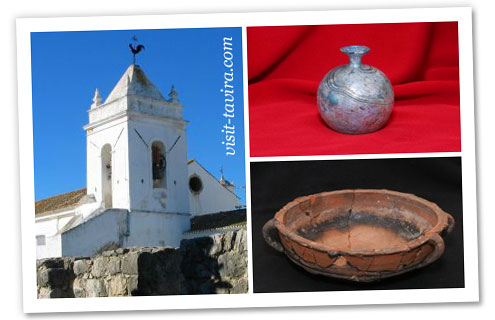Tavira’s monuments recount the important history of a city that was the largest in the Algarve in the 16th century. The Port of Tavira harboured the Portuguese fleet that patrolled the Strait of Gibraltar and supplied the markets of North Africa. It was a busy maritime commercial hub where fish, salt, citrus fruit, figs and almonds were exchanged for products from Flanders, India, China…
A number of writers have drawn attention to the city’s “oriental atmosphere”, unique to the region. The influence of the old port?
Visitors will find the remains of Phoenician walls in the open air to the rear of the Tourist Office. These will give rise to the Tavira Museum’s Phoenician Section. A series of “holy wells” dedicated to underground divinities can be visited in the atrium of the Palácio da Galeria.
Islamic Tavira will be made known at a section scheduled to open in the forthcoming months and where the famous “Tavira vase” will be exhibited. For the time being, apart from some 12th century Islamic wall coverings, a museum exhibit of an Almohad neighborhood can be seen at the Pousada/ Convento da Graça.
Tavira Castle, home to many alcaides and Christian governors, now has a landscaped garden, affording a panoramic view over the city, the river and the ocean.
St. Mary’s Church, built in the 13th century, was rebuilt after the 1755 earthquake, based on a neoclassic project by Italian Francisco Fabri, who traveled from the Algarve to Lisbon to build the Ajuda Palace.
The portal of the Misericórdia Church, built by master stonemason André Pilarte, who worked on the Jerónimos Monastery, and considered the most noteworthy example of Renaissance architecture in the Algarve, features imaginative Italian-style motives.
The Palácio da Galeria is the city’s most important civil building. It was remodeled during the 18th century under the guidance of Diogo Tavares de Ataíde, who designed a monumental baroque facade and kept the famous scissor-braced roofs. It was recuperated in 2001 to be used for cultural purposes, as an exhibition center and as the future City Museum.
Lavishly decorated in Rococo style, the Church of the Third Order of Carmo is of particular interest due to its gilt-carved retables and the Illusionist painting on the chancel ceiling. Tavira’s military tradition is clearly visible in the coastline fortifications and the Atalaia Barracks, built on the orders of D. Maria I in 1795, as a result of the need to reinforce the city’s defenses in the light of approaching attacks.
From the 19th century, we may appreciate the “iron architecture” at the Ribeira Market and the Coreto
Garden, which constituted a new area for socialising in the city. Over the last years, the recuperation and conversion of the Convent of Our Lady of Grace into a pousada (Architect João Campos) and the conversion of the former prison into the Álvaro de Campos Municipal Library (Architect Carrilho da Graça) deserve a special mention.
